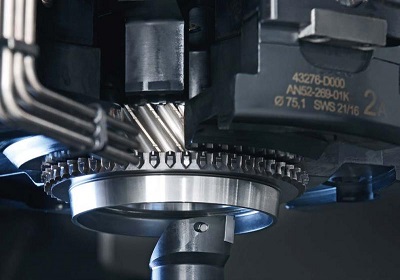
With the launch of the modular machine platform BV 235, BUDERUS Schleiftechnik is combining and optimising the tried-and-trusted advantages of two existing DVS modular systems and transferring these to a compact, adaptive machine design. The possibility of flexibly combining a wide range of different machining technologies, automation solutions and spindle variants permits highly efficient application- and user-specific hard-fine machining centres to be realised. The DVS company demonstrates the resulting customer benefit in terms of precision and cost using the example of the combined machining of a passenger car transmission gear wheel.
Users involved in the modern series production of passenger car and commercial vehicle components are currently being confronted with a whole range of challenges such as increasing cost pressure, limited planning resources, shorter implementation times and smaller production batches. In order to master these challenges not only today but in the future as well, manufacturing solutions are required which guarantee maximum flexibility and thus continued adaptability to changing general conditions thanks to combinable technology, automation and drive options tailored to suit the market's needs – and at the same time constantly ensuring maximum machining efficiency and quality. On the back of this development and the resulting customer requirements, BUDERUS Schleiftechnik is refining and integrating the design and technology features of the two DVS modular concepts CNC 235 and DVS ModuLine in its new modular machine platform BV 235. The deciding benefit for users of the new system: the enhanced technology, automation and drive variability allows project- or user-related engineering efforts to be reduced, ultimately leading to shorter throughput times and lower non-conformity costs in the hard-fine machining of chuck parts, shafts and gear wheels.
Modular system for application- and user-specific manufacturing solutions
BUDERUS Schleiftechnik demonstrates which concrete precision- and unit cost-related advantages the new platform is capable of, using the hard-fine machining of a passenger car transmission gear wheel as an example. In this case, a BV 235 machine with maximum configuration is used, equipped with technology modules for external, internal and face grinding as well as hard-turning, honing and measuring operations. In order to reduce machine investment and tool costs as well as remain within extremely stringent manufacturing tolerances, the DVS company is relying on a combination process consisting of external, internal and face grinding, hard turning and honing in just one clamping which can be realised using the BV 235 platform. Usually, strict shape, position and surface finish requirements in this context lead to a long chain of machining sequences. An effect which is additionally reinforced by the tribological requirements to minimise friction. Within the context of the conventional manufacturing sequence, hard-turning of the bore hole often takes place following the hardening process, and is in turn followed by a two- or three-stage honing process. Then the synchroniser cone as well as the front and rear face surfaces are ground. The hard-fine machining of the gear wheel is concluded by gear honing or grinding.
Efficient combined machining in one single clamping
In the course of the combination process, the gear wheel is loaded and removed from the work chamber using a V-loader. Picked up by the workpiece spindle and successively transported to the individual machining stations, the simultaneous CBN grinding of bore hole and cone is carried out first. A honing tool on the tool turret carries out finish-honing. The tool turret is also equipped with hard-turning tools which are used to carry out the concluding face surface machining. On the basis of detailed analyses of the BUDERUS combination process it can be proved that all the drawing tolerances of the bore hole are achieved by the CBN grinding i.e. without an additional honing process being necessary. Only few drawing specifications indicate implicit surface requirements – such as a broke grinding texture through cross-grinding or plateau surface – which are achieved by the downstream finish-honing. However, as with super-finishing, the grinding process mainly defines the position, bore hole dimension and shape in this case as well. The task of finish-honing is simply to remove material from the ground surface, so that an extremely finely honed surface profile is achieved in the bore hole despite a significantly reduced honing allowance which is only three to five percent of the conventional allowance.
Greater precision, lower costs
This culminates in considerable cost savings for the user: while up to three machines including the respective concatenation are required for the conventional process sequence, combination machining takes place in one single BV 235 machine. The capital expenditure is thus reduced by more than 50 %. The savings are just as significant in terms of running costs: due to the reduced honing allowance, the service life of the expensive honing tool is significantly increased, resulting in a reduction of tool costs by more than two thirds. Compared with the conventional machining sequence, savings can also be made in terms of machine footprint, energy costs and expenditure for cooling lubricants. Moreover, the measured results illustrated as examples are proof of the high manufacturing quality achieved for the gear wheels with the aid of the combination process in the specially configured BV 235 machine. The roughness value Rz is consistently below the given drawing tolerance, while both the specific concentricity and parallelism requirements – both smaller than the drawing tolerance of 4 µm – are clearly achieved.
With the introduction of the BV 235 platform, BUDERUS Schleiftechnik is creating an optimised modular system, the performance of which is impressively demonstrated by the combination process described and the modularity of which covers a wide range of different hard machining tasks for many different chuck parts, shafts and gear wheels. This means that users benefit – in terms of both costs and precision – from manufacturing solutions that can be designed to match specific requirements and adapted flexibly to changing conditions.
Marki
 iConnectHub
iConnectHub
 Login/Register
Login/Register Supplier Login
Supplier Login


























